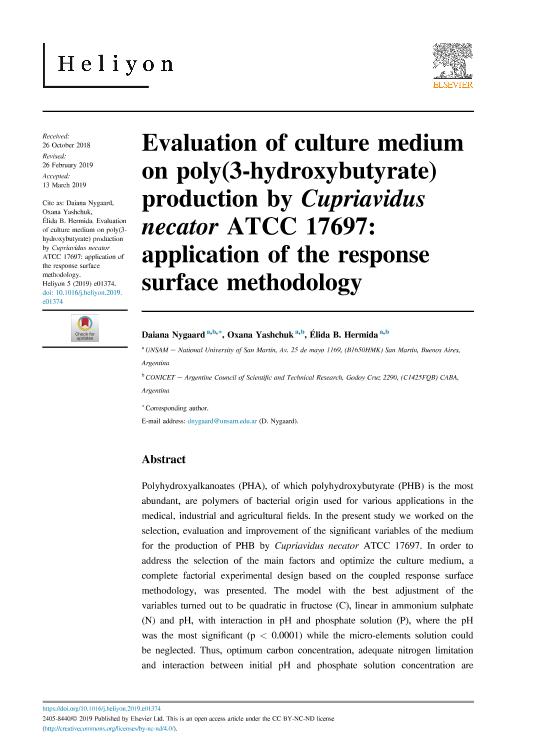Artículo
Evaluation of culture medium on poly(3-hydroxybutyrate) production by Cupriavidus necator ATCC 17697: application of the response surface methodology
Fecha de publicación:
03/2019
Editorial:
Elsevier
Revista:
Heliyon
ISSN:
2405-8440
Idioma:
Inglés
Tipo de recurso:
Artículo publicado
Clasificación temática:
Resumen
Polyhydroxyalkanoates (PHA), of which polyhydroxybutyrate (PHB) is the most abundant, are polymers of bacterial origin used for various applications in the medical, industrial and agricultural fields. In the present study we worked on the selection, evaluation and improvement of the significant variables of the medium for the production of PHB by Cupriavidus necator ATCC 17697. In order to address the selection of the main factors and optimize the culture medium, a complete factorial experimental design based on the coupled response surface methodology, was presented. The model with the best adjustment of the variables turned out to be quadratic in fructose (C), linear in ammonium sulphate (N) and pH, with interaction in pH and phosphate solution (P), where the pH was the most significant (p < 0.0001) while the micro-elements solution could be neglected. Thus, optimum carbon concentration, adequate nitrogen limitation and interaction between initial pH and phosphate solution concentration are important factors to ensure a high production of PHB. The optimal values of the selected variables were C = 20 g/l, N = 1.5 g/l, P = 8.75 g/l and pH 7.5. A maximum PHB production of 4.6 g/l, obtained under these conditions, increased almost 2.5 times. The polymer accumulated in the cytoplasm of C. necator ATCC 17697 in the form of granules showed an FTIR spectrum corresponding to that of commercial PHB.
Archivos asociados
Licencia
Identificadores
Colecciones
Articulos(SEDE CENTRAL)
Articulos de SEDE CENTRAL
Articulos de SEDE CENTRAL
Citación
Nygaard, Daiana; Yashchuk, Oxana; Hermida, Elida Beatriz; Evaluation of culture medium on poly(3-hydroxybutyrate) production by Cupriavidus necator ATCC 17697: application of the response surface methodology; Elsevier; Heliyon; 5; 3; 3-2019; 1-18
Compartir
Altmétricas




